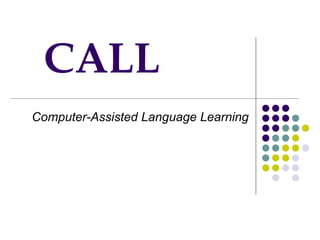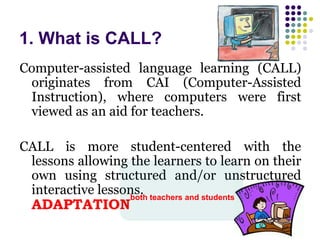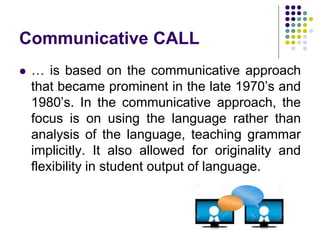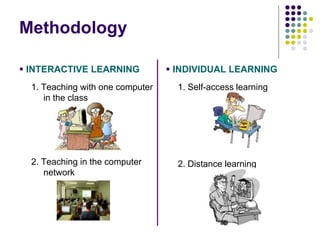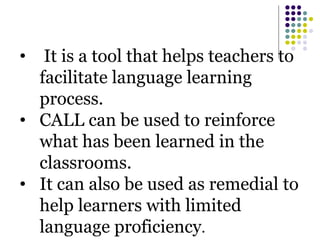Computer Assisted Language Learning
- 2. 1. What is CALL? Computer-assisted language learning (CALL) originates from CAI (Computer-Assisted Instruction), where computers were first viewed as an aid for teachers. CALL is more student-centered with the lessons allowing the learners to learn on their own using structured and/or unstructured interactive lessons. ADAPTATION both teachers and students
- 3. Typology and periods ’ü¼ Behavioristic CALL 1950s-1980s ŌĆó Communicative/Cognitive CALL 1980s-1990s ŌĆó Integrative/ Explorative CALL 1990s-present ’üČMultimedia ’üČinternet
- 4. Behaviorist CALL ’ü¼ From B.F SkinnersŌĆÖs behaviorist approach that repeated exposure to material was considered to be beneficial or even essential, computers were considered ideal for this aspect of learning as the machines did not bored or impatient learners and the computer could present material to the student as his/her own pace and even adapt the drills to the level of the student.
- 5. Communicative CALL ’ü¼ ŌĆ” is based on the communicative approach that became prominent in the late 1970ŌĆÖs and 1980ŌĆÖs. In the communicative approach, the focus is on using the language rather than analysis of the language, teaching grammar implicitly. It also allowed for originality and flexibility in student output of language.
- 6. Integrative or explorative CALL ’ü¼ starting from the 1990ŌĆÖs, tries to address these criticisms by integrating the teaching of language skills into tasks or projects to provide direction and coherence. ’ü¼ It also coincides with the development of multimedia technology (providing text, graphics, sound and animation) as well as computer-mediated communication.
- 7. Methodology ’é¦ INTERACTIVE LEARNING 1. Teaching with one computer in the class 2. Teaching in the computer network ’é¦ INDIVIDUAL LEARNING 1. Self-access learning 2. Distance learning
- 8. ŌĆó It is a tool that helps teachers to facilitate language learning process. ŌĆó CALL can be used to reinforce what has been learned in the classrooms. ŌĆó It can also be used as remedial to help learners with limited language proficiency.
- 9. REFERENCES ’ü¼ www.ict4lt.org/en/warschauer.htm ’ü¼ www.uned.es/ca-tudela/revista/n002/raul_santiago.htm ’ü¼ www.wik.ed.uiuc.edu/index.php/CALL:Computer_Assiste d_Language_Learning ’ü¼ Bax,S. (2003). CALL ŌĆō past, present and future. System, 31 (1): 13-28. ’ü¼ www.kn.pacbell.com/wired/fil/pages/listweb20s.html ’ü¼ www.classroom20.com/
- 10. Thank you for your attention!
Editor's Notes
- #5: ’éŚ Because repeated exposure to material was considered to be beneficial or even essential, computers were considered ideal for this aspect of learning as the machines did not get bored or impatient with learners and the computer could present material to the student as his/her own pace and even adapt the drills to the level of the student.
